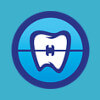Emergency Care
True orthodontic emergencies are rare, but when they occur we are available to you. As a general rule, you should call our office when you experience severe pain or have a painful appliance problem you can't take care of yourself. We'll be able to schedule an appointment to resolve the problem.
You might be surprised to learn that you may be able to solve many problems yourself temporarily until you can get to our office. If there is a loose piece that you can remove, put it in a plastic bag or envelope and bring it with you to your next appointment. If your braces are poking you, put soft wax on the piece that's sticking out. If the wire has slid to one side, you can pull it back to the other side with needle-nosed pliers, replacing it in the tube on the back tooth.
After alleviating your discomfort, it is very important that you still call our office as soon as possible to schedule a time to repair the problem. Allowing your appliance to remain damaged for an extended period of time may result in disruptions to your treatment plan.
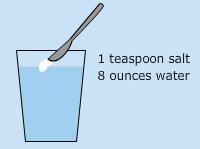
General soreness
When you get your braces on, you may feel general soreness in your mouth, and teeth may be tender to biting pressures for three to five days. Stick to a soft diet until your teeth do not hurt to chew. Irritated gums and other sore spots can be relieved by rinsing your mouth with a warm salt-water mouthwash. Dissolve one teaspoonful of salt in eight ounces of warm water, and rinse your mouth vigorously. If the tenderness is severe, take Acetaminophen (Tylenol) or whatever you normally take for headache or similar pain. Aspirin, Ibuprofen (Motrin, Advil) and Naproxen Sodium (Naprosyn, Anaprox) actually slow the tooth movement, so it is not advisable to use them frequently while wearing braces.
The lips, cheeks, and tongue may become irritated for one to two weeks as they learn a new posture and become accustomed to the surface of the braces. You can put wax on the braces to lessen this. We'll show you how!
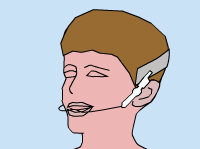
Headgear
Sometimes discomfort is caused by not wearing the headgear as instructed by your orthodontist. Please refer to the instructions provided by your orthodontist. If the facebow (metal piece) is bent, please call our office for assistance. The headgear should hurt less the more it's worn, so be sure you get in the prescribed number of hours.
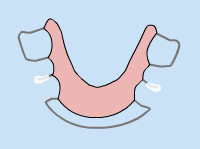
Loose appliance
If your appliance is poking you, place wax on the offending part.
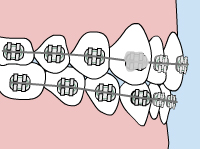
Loose bracket
If your bracket or band is still attached to the wire, you should leave it in place and put wax on it if needed for comfort. If the bracket or band can be removed easily, place it in an envelope and save it to bring to your next appointment.
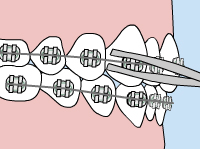
Loose wire
Using a pair of tweezers or needle-nosed pliers, try to put your wire back into place. It is okay to use a piece of floss to tie the wire into place: tie the floss around the bracket in place of the missing colored o-ring. If you cannot put the wire into a comfortable position, and covering the end with wax doesn't help, as a last resort use a small fingernail clipper to clip the wire behind the last tooth to which it is securely fastened. If the end of the wire is still sharp place wax on it.
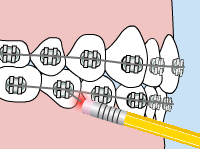
Poking wire
Using a pencil eraser, push the poking wire down or place wax on it so that it is no longer poking.
What To Do With Common Injuries
What if you and some friends were playing an informal game of basketball and one of your friends was struck down by a hard jab to the mouth? Could you help? What if you were the one to fall face down, only to find blood pouring from your aching nose? Would anyone with you know basic first aid?
It is important to be prepared in case such misfortune takes place. Three dental specialties, the American Association of Oral and Maxillofacial Surgeons (AAOMS), American Academy of Pediatric Dentistry (AAPD) and American Association of Orthodontists (AAO), offer the following first aid tips to assist you in case an accident occurs:
Broken tooth
- Clean the injured area and apply ice.
- Save the tip of the tooth (for possible reattachment) and call your dentist right away.
Knocked out teeth
- See your dentist immediately.
- Upon locating the tooth, hold it by the crown (the wide part, not the pointed end/root).
- Rinse the tooth but avoid rubbing it or touching the root.
- Put the tooth back in its socket; cover with gauze or and wn stabilize it. Or, briefly store the tooth in cold milk or salt water, or between the cheek and gum.
- Do not let the tooth dry out. A tooth can usually be saved if cared for properly and reimplanted within an hour.
Facial cuts
- Cover the wound with a clean dressing and apply pressure.
- Dressing may become saturated; do not remove it. Apply more dressing and pressure.
- Go to a nearby hospital for emergency assistance.
Cuts inside of the mouth
- Gently rinse the mouth with cold water.
- Bite on some gauze, a clean cloth or tissue and apply pressure to the wound.
- Go to the closest hospital emergency department for immediate treatment.
Jaw injury
If teeth fit together properly when the mouth is closed:
- Apply ice to control swelling and take ibuprofen or a similar remedy to control pain.
- Restrict diet to soft foods and if no improvement occurs within 24 hours, seek dental care.
If teeth do not fit together properly when the mouth is closed:
- Immediately seek emergency care.
- Gently align the jaws.
- Immobilize the jaw; wrap a cloth bandage under the chin and secure it over the head.
- Apply ice to control swelling.
Broken nose
- Gently pack the nose with gauze or tissue.
- Apply ice. Do not blow nose.
Head and neck injury
- Do not let the injured person be moved unless done by professionals or if in danger.
- Immobilize the head by placing rolled towels on either side.
- Avoid risk of shock by keeping the injured person warm.
- If unconscious, clear the person’s mouth and hold their tongue forward to maintain an open airway. Seek emergency care.
Originally Published by AAOMS


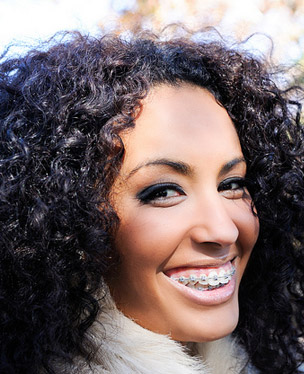
 Website Powered by Sesame 24-7™
Website Powered by Sesame 24-7™ 